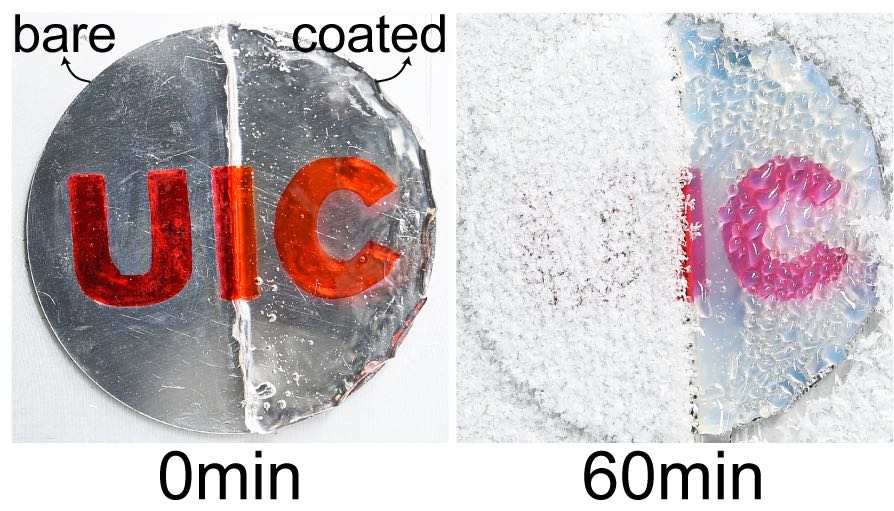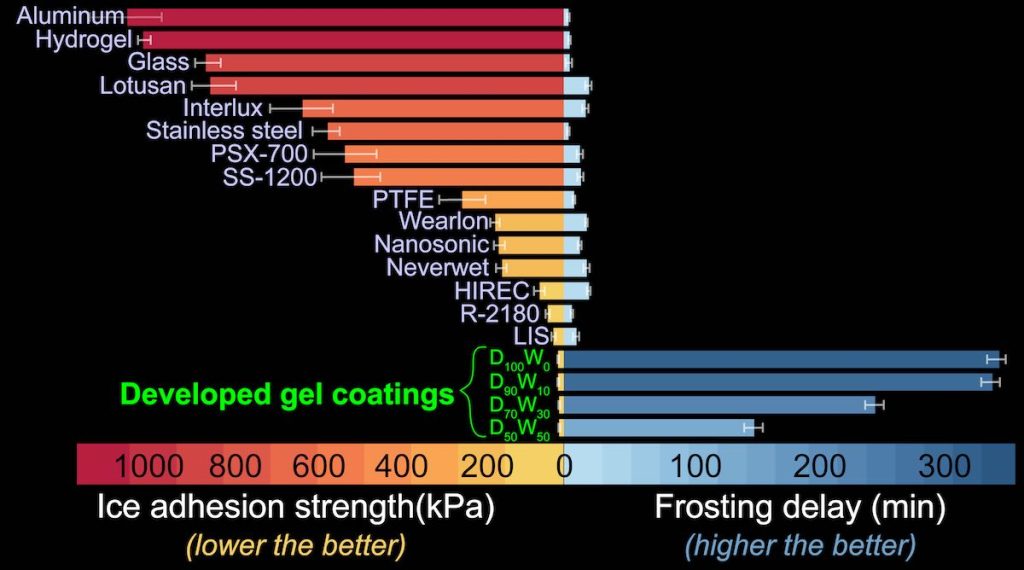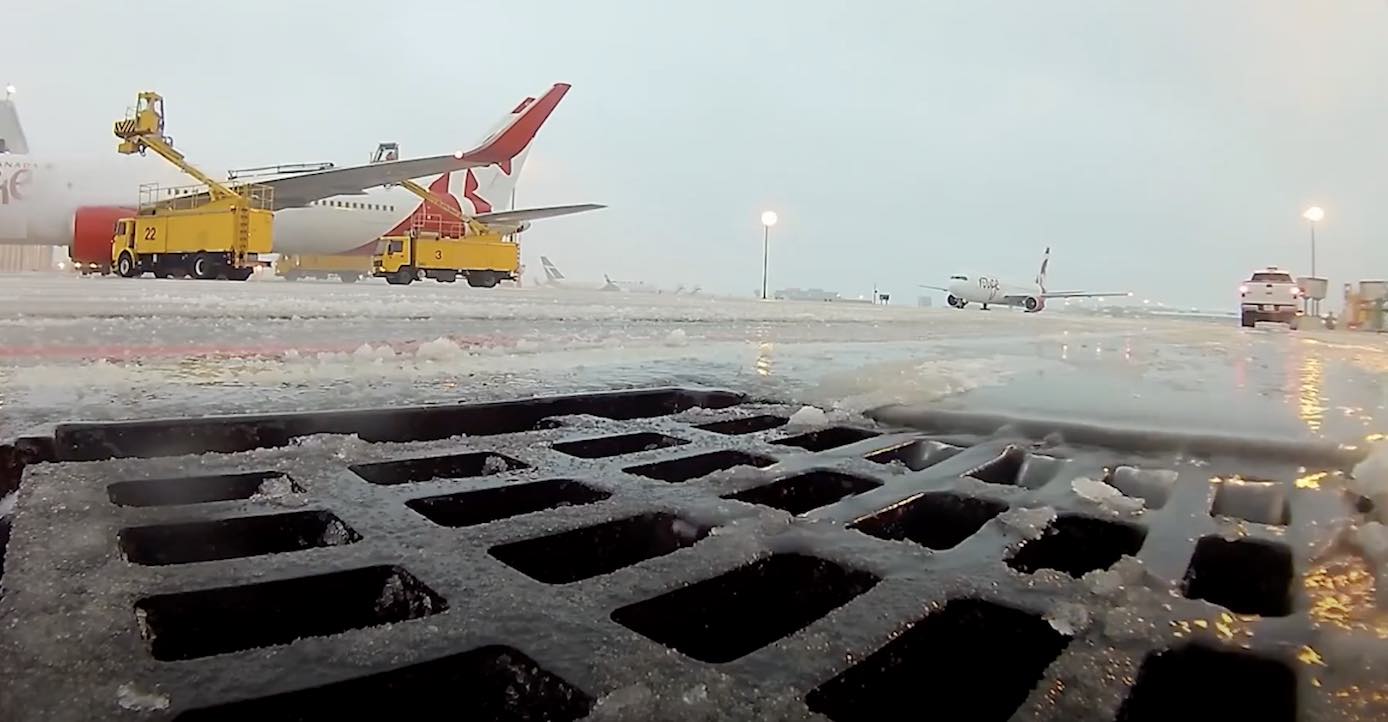Airports delays are common, but especially during winter when jets need to be dowsed with thousands of gallons of deicing fluids to prevent ice formation and maintain the plane’s aerodynamics to avoid fatal accidents like the tragic Air Florida flight that fell into the Potomac River in Washington, DC directly after lift-off in a 1982 snow storm.
But as soon as any de-iced airplane takes off, most of the liquid slides from the surface of the aircraft and ends up polluting streams, lakes, and oceans.
Now, endeavoring to make a more efficient product immune to ice for such demanding industries, a team at the University of Illinois Chicago have developed a longer-lasting and eco-friendly alternative to conventional deicers.
“Glycols dissolve very fast and get washed away before the plane takes off, and it’s a serious problem that costs hundreds of millions of dollars—most of which literally ends up in the drain,” said Sushant Anand, assistant professor of mechanical engineering. “We thought, why not improve such chemicals themselves, and make alternatives that can last longer while being more biofriendly. And that is what we ended up doing.”
Working with Ph.D. student Rukmava Chatterjee, they accomplished their goal by developing 80 different anti-freezing coatings, which can be classified as polymeric solutions, emulsions, or gels. The formulations can be easily applied to aluminum, steel, copper, glass, plastic or any industrial surface without preconditioning or expensive surface treatments.
“Our coatings are an all-in-one package which can delay formation of frost for extended hours, and simultaneously cause any ice formed on its surface to easily shed off by a gentle breeze or simple substrate tilting,” Chatterjee said.
The anti-freezing gels are also transparent, which is critical for applications like traffic signals, runway lights that assist pilots during landings, automotive windshields, or building windows.

They worked with phase change materials because they had a melting point above the freezing point of water (0 degrees C). This means under sub-zero temperatures the materials are in their solid state, just like chocolate, butter, or water itself.
The multifunctional coatings can prevent the adhesion of ice (or bacteria) on surfaces, irrespective of their inherent material structure and chemistry. This was engineered by regulating how chemicals leach out of the material system and by creating a lubricating surface layer that is both slippery and non-freezing in nature.
Chatterjee told GNN that the idea came to him and his PhD advisor Prof. Anand back in 2016.
“It was February and I was flying out from Chicago to deliver a talk in an international conference on ice/frost protection technologies. Quite an irony! It was a frigid winter day and the flight was already delayed due to icing issues. As a plane full of frustrated passengers waited inside the aircraft for two hours, we watched the plane getting dowsed continuously with thousands of gallons to prepare it for a safe take-off. Later, I missed my next connecting flight due to this delay and had to drive overnight to the conference venue.”
“Since then we have been researching, formulating compositions & exhaustively testing them under real-life winter conditions to address this long standing issue. Being liquid, all these chemicals get easily dissolved away or sheared off, the moment the flight takes off. Our idea was to use certain materials which are solid when cold.”
“In our latest work we identified a family of these materials and encapsulated them in a polymer matrix. The objective being to preserve their native anti-icing property but to increase their lifetime,” he continued. “We prepared more than 80 such formulations in the form of sprayable solutions, emulsions, creams & gels. They can be easily sprayed or coated on any industrial surface (metal/ glass/ plastics) without the need for any special surface treatment.”

“A key point was to use materials which are bio-friendly. For example the anti-freezing gels we prepared are made of dimethyl sulfoxide (a by-product of plant industry and having miraculous medicinal properties) and gelatin (the stuff you use in making deserts and custards): so all very safe items.”
The gels are the best performing ones and have a significant edge amongst the developed formulations. They are easy to fabricate, require only two components, they can be easily cured/sprayed/painted/coated on any surface, regardless of shape. The best part is they are optically transparent even under icing/frosting conditions.
Their research published in Advanced Materials showed that, compared to commercial coatings available in today’s market, they perform better by an order of magnitude after exhaustive testing.
Chatterjee told GNN the gels are also anti-bacterial in nature. “Imagine coating your smart-watch (or any wearable electronic) with this gel and using it in winter. It can potentially prevent your watch’s battery from dying in the cold while also preventing it from bacterial contamination, thereby precluding the need for constant sanitization.”
RELATED: This Plant-Based Jet Fuel Can Reduce Emissions by 68% – Without Displacing Crops
For aerodynamic testing, the team coated a propeller blade and tested its anti-frosting performance under sub-zero winter conditions. They also subjected the coatings to very high shear airflow, simulating the conditions of a hurricane and tested their anti-frosting performance thereafter.
Of course, more exhaustive testing on actual airplanes in wind-turbines are needed to pass industrial test requirements before adopting them for real-life usage, but they do promise significant improvement over many commercial solutions available in the market presently.
“Since our anti-icing sprays are bio-friendly and anti-bacterial, we even think there is a potential to use them in agriculture to prevent crops from being ruined by severe frost,” Anand said. “But that is a pipe dream, and we need to do more studies to see if there will be any long-term adverse effect on the plants.”
MORE: A Flying Car Just Got Certified as Airworthy to Fly
A worldwide patent application titled “Compositions and Methods for Inhibiting Ice Formation on Surfaces” has been filed by UIC’s Office of Technology Management. Watch the video below for more information…
FLY THIS Great Idea to All Your Brilliant Friends on Social Media…





















Thank you to the wonderful scientists who figured out things like freezing point, and making the material biofriendly. We appreciate those with the gifts of science and patience in figuring out what might work in the real world!